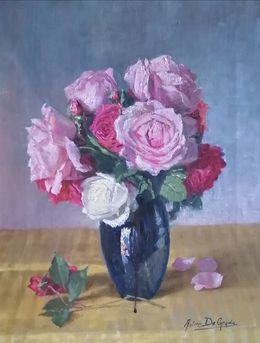
Bouquet de roses
Antonio De Grada
Painting - 47 x 36.5 x 2 cm Painting - 18.5 x 14.4 x 0.8 inch
Sold
Italian decorative painter born in 1858 in Milan. He died in 1938 in Switzerland. Son of Raffaele and Alessandro de Grada. Since 1876 he has commissioned works in Switzerland.
The lexicographical article Antonio de Grada was published on May 14, 1894. Little is known about his parental home so far. Very early on, he drew and painted. Thus, after compulsory education and training under the guidance of competent masters, he worked from 1874 to 1876 with a certain Fioroni and later as a freelance fresco painter. In 1883 he married Teresa Amelotti in Mede. In northern Italy, he decorated churches, villas and palaces with frescoes. Recognition of his name has increased. In 1890, the painter-decorator was called to Buenos Aires by the Argentine president to decorate his palace. In 1894 he was invited by the architect Alfred Chiodera, who worked in Milan and Zurich. De Grada had already done commission work for him earlier in Graubünden. The close collaboration between the decorative painter and the famous Zurich architectural duo Chiodera Tschudy secured him permanent orders and therefore also ensured the economic existence of his family, who now also lived in the town on the Limmat.
After first working for the decorative painting company Witt Ott and with Richard Thal, de Grada founded his own decorative painting studio in Zurich-Selnau in 1898. The studio flourished and sometimes had more than a dozen employees. The two sons Raffaele and Alessandro Edoardo imitated their father and helped in the business. At the time, the studio was able to artistically decorate entire homes with the vast array of decorative works. While Raffaele returned to Italy in 1915, Alessandro Edoardo took over his father's business in 1931 and ran it until his death in 1955. Antonio himself returned to his hometown of Milan in 1935, where he died on October 28, 1938 died. In the obituary section of the evening newspaper of the Neue Zürcher Zeitung at 7 p.m. In November 1938 Antonio was called a great painter whose life and work have been closely linked to Zurich and the German part of Switzerland for decades.
A kind man, who was also held in high esteem in the Italian colony of Zurich, died with him Scientific research has unearthed decorative paintings in over 50 buildings, often public such as post offices and banks, and in villas throughout German-speaking Switzerland, as well as around twenty paintings and sketches (still lifes of flowers, fruits, hunting, landscapes, portraits and representations of the Virgin Mary) in private collections. In de Grada's work, we can see a shift from historicism to Art Nouveau. His main work is the design of the facade of the Four Times of the Day at Bleicherweg 45 in Zurich (1906), which is inspired by Art Nouveau. Other works of interest can be found at Villa Patumbah in Zurich and at Villa Dem Schönen, now the Liceo Artistico in Zurich-Enge. The decorative paintings and paintings by De Grada are of great artistic quality. He knew very well how to handle the most diverse techniques and materials. The spectrum ranges from sgraffito, fresco, secco, painting behind glass, oil painting and watercolors to tapestry painting. de Grada presented his leisure activity. Painting in several exhibitions (Künstlerhaus Zürich, Kunsthaus Zürich). His undated hunting still life La Lepre received a gold medal at the 1907 exhibition at Glass Palace in London. Works: Zurich, Bleicherweg 41, Klotho mit der Spindel des Lebensfadens, 1898, fresco; Zurich, Bleicherweg 45, Vier Tageszeiten, 1906, secco; Zurich, Villa Hommel (Villa Dem Schönen, Liceo Artistico), Parkring 30, c. 1899-1903, fresco and oil paintings; Zurich, Villa Patumbah, Zollikerstrasse 128, c. 1899, fresco.

Painting - 47 x 36.5 x 2 cm Painting - 18.5 x 14.4 x 0.8 inch
Sold
What are their 3 main works?
When was Antonio De Grada born?